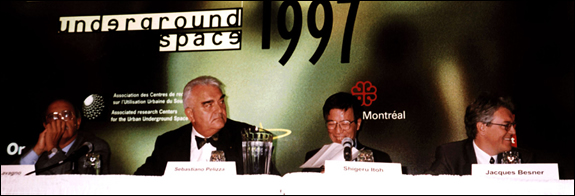7th International Conference – Montréal 1997: “Underground Space: Indoor Cities of Tomorrow”
Following the 6th conference held in Paris, in 1995, the City of Montréal had hosted the 7th meeting under the auspices of ACUUS, the international organisation that will co-ordinate all subsequent conferences in the series.This conference, “Underground Space: Indoor Cities of Tomorrow”, had focused on possible future partnerships and the interdisciplinary that must exist to create what are often colossal underground projects. Partnerships and interdisciplinary work are closely linked to the multiple facets involved in the construction of any underground project. They include: analysis, planning, financing, regulation, construction, technology, management, administration, promotion, marketing, maintenance, security, signage and even activity-planning. Four major themes were reviewed over the three main days of the conference: Partnership, Interdisciplinarity, Indoor Cities, and Technological Innovations.

Partnership workshops had examined urban planning teamwork and responsibility sharing between public- and private sector decision-makers involved in the underground development of our cities. Discussion had also focused on partnerships regarding all aspects of underground security, notably user safety, fire/crime prevention and response, communications, building security and underground construction codes. In addition, these working groups had addressed partnerships formed to build underground projects, rehabilitate infrastructures as well as develop signage and user communications.
The workshops on interdisciplinarity had explored progress made by underground experts, particularly studies on user behavior and perception of subterranean space. They had also looked at underground urban planning, the architecture and design of indoor spaces and the placement of interior passages. Legal and fiscal analysis, financial issues as well as economic and feasibility studies have been discussed.Indoor cities workshops had used case studies of existing projects in certain urban centers, such as subways, subterranean stations and pedestrian malls to analyze their impact on underground mobility, transportation, commercial activity and shopping malls as well as on the city as a whole and its citizens.The working sessions had bearings on specific technological innovations affecting underground construction as well as three-dimensional models of excavations and databases. Participants had discussed excavated structures, mastering of geological constraints, equipment, tunnels and new techniques in rebuilding infrastructures and public utilities.
The 7th ACUUS International Conference “Underground Space : Indoor Cities of Tomorrow” has been organized by the City of Montréal, in collaboration with the University of Montréal and under the auspices of the International Tunneling Association (AITES / ITA) which was the sponsor of the event. The Conference was also under the high patronage of UNESCO.
Jacques BESNER, President of the Organizing Committee
Organizing Committee of the 7th Int’l Conference
City of Montreal
A CD-ROM, ISBN: 2-89417-725-9, is available at the Secretariat of ACUUS at the price of 100 $ Can tx incl. (postage not included)
The Table of Contents of the Proceedings can be found here